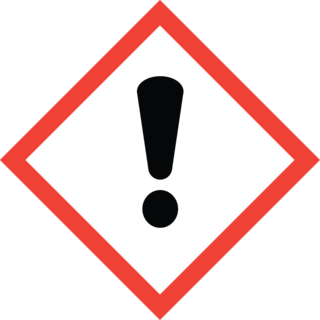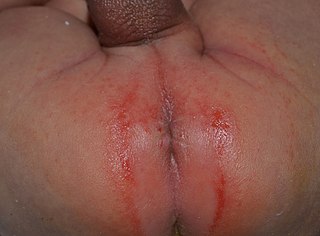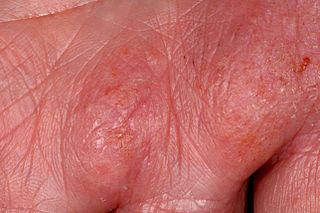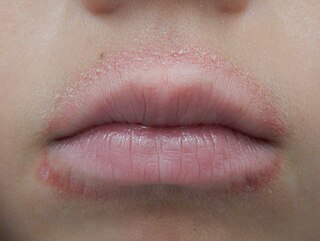Related Research Articles

Dermatitis is inflammation of the skin, typically characterized by itchiness, redness and a rash. In cases of short duration, there may be small blisters, while in long-term cases the skin may become thickened. The area of skin involved can vary from small to covering the entire body. Dermatitis is often called eczema, and the difference between those terms is not standardized.

Irritation, in biology and physiology, is a state of inflammation or painful reaction to allergy or cell-lining damage. A stimulus or agent which induces the state of irritation is an irritant. Irritants are typically thought of as chemical agents but mechanical, thermal (heat), and radiative stimuli can also be irritants. Irritation also has non-clinical usages referring to bothersome physical or psychological pain or discomfort.

Irritant diaper dermatitis is a generic term applied to skin rash in the diaper area that are caused by various skin disorders and/or irritants.

Contact dermatitis is a type of acute or chronic inflammation of the skin caused by exposure to chemical or physical agents. Symptoms of contact dermatitis can include itchy or dry skin, a red rash, bumps, blisters, or swelling. These rashes are not contagious or life-threatening, but can be very uncomfortable.

Nummular dermatitis is one of the many forms of dermatitis. It is characterized by round or oval-shaped itchy lesions. The name comes from the Latin word "nummus," which means "coin."

A moisturizer, or emollient, is a cosmetic preparation used for protecting, moisturizing, and lubricating the skin. These functions are normally performed by sebum produced by healthy skin. The word "emollient" is derived from the Latin verb mollire, to soften.
An occupational disease or industrial disease is any chronic ailment that occurs as a result of work or occupational activity. It is an aspect of occupational safety and health. An occupational disease is typically identified when it is shown that it is more prevalent in a given body of workers than in the general population, or in other worker populations. The first such disease to be recognised, squamous-cell carcinoma of the scrotum, was identified in chimney sweep boys by Sir Percival Pott in 1775. Occupational hazards that are of a traumatic nature are not considered to be occupational diseases.

Desonide (INN) is a low-potency topical corticosteroid anti-inflammatory that has been available since the 1970s. It is primarily used to treat atopic dermatitis (eczema), seborrheic dermatitis, contact dermatitis and psoriasis in both adults and children. It has a fairly good safety profile and is available as a cream, ointment, lotion, and as a foam under the tradename Verdeso Foam. Other trade names for creams, lotions, and ointments include Tridesilon, DesOwen, Desonate. It is a group VI corticosteroid under US classification, the second least potent group.

Perioral dermatitis, also known as periorificial dermatitis, is a common type of skin rash. Symptoms include multiple small (1–2 mm) bumps and blisters sometimes with background redness and scale, localized to the skin around the mouth and nostrils. Less commonly the eyes and genitalia may be involved. It can be persistent or recurring and resembles particularly rosacea and to some extent acne and allergic dermatitis. The term "dermatitis" is a misnomer because this is not an eczematous process.

Allergic contact dermatitis (ACD) is a form of contact dermatitis that is the manifestation of an allergic response caused by contact with a substance; the other type being irritant contact dermatitis (ICD).
Irritant contact dermatitis is a form of contact dermatitis that can be divided into forms caused by chemical irritants and those caused by physical irritants.

Cetaphil or is a line of skin care products from the Swiss company Galderma, including cleansers, bar soap, cream, lotion, and moisturizers. It was developed in 1947, in Texas, by an American pharmacist. Cetaphil products are available worldwide in more than 70 countries, commonly sold at grocery stores and pharmacies throughout the United States, Canada and India. They are also available in pharmacies in Australia, Hong Kong, South Korea, Indonesia, the Philippines, South Africa, Singapore, some European, Latin American and Caribbean countries.

Lotion is a low-viscosity topical preparation intended for application to the skin. By contrast, creams and gels have higher viscosity, typically due to lower water content. Lotions are applied to external skin with bare hands, a brush, a clean cloth, or cotton wool.
Xerotic eczema is a form of eczema that is characterized by changes that occur when skin becomes abnormally dry, red, itchy, and cracked. It tends to occur more often during the winter and in dry conditions.
Personal care products are consumer products which are applied on various external parts of the body such as skin, hair, nails, lips, external genital and anal areas, as well as teeth and mucous membrane of the oral cavity, in order to make them clean, protect them from harmful germs and keep them in good condition. They promote personal hygiene and overall health, well-being and appearance of those body parts. Toiletries form a narrower category of personal care products which are used for basic hygiene and cleanliness as a part of a daily routine. Cosmetic products, in contrast, are used for personal grooming and beautification. Pharmaceutical products are not considered personal care products.
Eyelid dermatitis is commonly related to atopic dermatitis or allergic contact dermatitis. Volatile substances, tosylamide, epoxy hardeners, insect sprays, and lemon peel oil may be implicated, with many cases of eyelid contact dermatitis being caused by substances transferred by the hands to the eyelids.

Hand eczema presents on the palms and soles, and may sometimes be difficult or impossible to differentiate from atopic dermatitis, allergic contact dermatitis, and psoriasis, which also commonly involve the hands. Even a biopsy of all these conditions may not result in a definitive diagnosis, as all three conditions may demonstrate spongiosis and crusting on the hands.
Occupational skin diseases are ranked among the top five occupational diseases in many countries.

Lip licker's dermatitis is a type of skin inflammation around the lips due to damage by saliva from repetitive lip licking and is classified as a subtype of irritant contact cheilitis. The resulting scaling, redness, chapping, and crusting makes a well-defined ring around the lips. The rash may extend as far as the tongue can reach and usually does not occur at the corners of the mouth. It commonly occurs during winter months but some people can have it year-round if lip licking is a chronic habit.

Dermatoses induced by Personal Protective Equipment are skin lesions that occur due to the use of personal protective equipment (PPE). Personal Protective Equipment such as masks, face shields, goggles, gloves and gowns can cause abrasion in the skin and retain moisture in body parts, particularly the face. During the COVID-19 pandemic, healthcare workers and general public need to use personal protective equipment, sometimes for extended duration, which may result in skin problems due to friction, pressure, long-term sealing and moisture retention.
References
- 1 2 3 4 Bauer, Andrea; Rönsch, Henriette; Elsner, Peter; Dittmar, Daan; Bennett, Cathy; Schuttelaar, Marie-Louise A.; Lukács, Judit; John, Swen Malte; Williams, Hywel C. (April 30, 2018). "Interventions for preventing occupational irritant hand dermatitis". The Cochrane Database of Systematic Reviews. 2018 (4): CD004414. doi:10.1002/14651858.CD004414.pub3. ISSN 1469-493X. PMC 6494486 . PMID 29708265.
- ↑ Wilhelm, Klaus Peter; Zhai, Hongbo; Maibach, Howard I. (November 26, 2007). Dermatotoxicology. CRC Press. p. 299. ISBN 9781420009774.
BC are also called 'skin protective creams' (SPCs) or 'protective creams' as well as 'protective ointments', 'invisible glove', 'barrier', 'protective', or 'prework' creams and gels (lotions), 'antisolvent' gels, and so on. Kresken and Klotz (2003) believe that the term 'invisible glove' is incorrect and it might mislead the user. Frosch et al. (1993a) consider SPC a more appropriate terminology since most creams do not provide a real barrier, at least not comparable to stratum corneum. We utilize BC here because this term is in general usage in industry.
- 1 2 Safety & Health: SH. Vol. 172–173 (Digitized June 1, 2010 ed.). The Council. 2005.
- 1 2 Holt, Allan St John (June 9, 2008). Principles of Construction Safety. John Wiley & Sons. p. 177. ISBN 9780470763353.
- 1 2 3 4 5 6 7 8 9 10 11 12 13 14 Corazza M, Minghetti S, Bianchi A, Virgili A, Borghi A (2014). "Barrier creams: facts and controversies". Dermatitis. 25 (6): 327–33. doi:10.1097/DER.0000000000000078. PMID 25384222. S2CID 24884588.
- 1 2 3 4 Zhai H, Maibach HI (2002). "Barrier creams--skin protectants: can you protect skin?". Journal of Cosmetic Dermatology. 1 (1): 20–3. doi:10.1046/j.1473-2130.2001.00006.x. PMID 17134447. S2CID 80542190.
- 1 2 Robert L. Rietschel; Joseph F. Fowler; Alexander A. Fisher (2008). Fisher's Contact Dermatitis. PMPH-USA. pp. 333–. ISBN 978-1-55009-378-0.
- 1 2 3 4 5 Richard J. G. Rycroft (January 1, 2001). Textbook of Contact Dermatitis. Springer Science & Business Media. pp. 989–. ISBN 978-3-540-66842-8.
- 1 2 Lebwohl, Mark G.; Heymann, Warren R.; Berth-Jones, John; Coulson, Ian, eds. (September 19, 2013). Treatment of Skin Disease: Comprehensive Therapeutic Strategies. Elsevier Health Sciences UK. pp. 336–. ISBN 978-0-7020-5236-1.
- 1 2 3 4 "WHO Guidelines on Hand Hygiene in Health Care: First Global Patient Safety Challenge Clean Care Is Safer Care". WHO Press. 2009. Retrieved October 2, 2015.
- ↑ John M. Boyce; Didier Pittet (October 17, 2002). "Guideline for Hand Hygiene in Health-Care Settings". Morbidity and Mortality Weekly Report .
- ↑ Susan Macqueen (June 18, 2012). The Great Ormond Street Hospital Manual of Children's Nursing Practices. John Wiley & Sons. pp. 181–. ISBN 978-1-4051-0932-1.
- ↑ Schliemann S, Elsner P (2014). "Prevention of Hand Eczema: Barrier Creams and Emollients". Textbook of Hand Eczema. Springer. pp. 273–278. doi:10.1007/978-3-642-39546-8_26. ISBN 978-3-642-39545-1.
- ↑ Kurpiewska J, Liwkowicz J (2014). "[Barrier creams in prevention of hand dermatoses]". Medycyna Pracy (in Polish). 65 (2): 297–305. PMID 25090859.